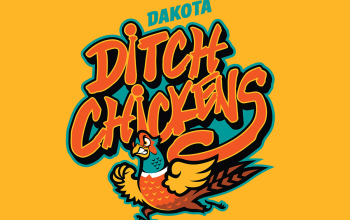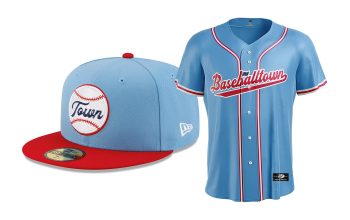I’m sure we all remember where we were when Phillies rookie Odubel Herrera hit his first career home run on Monday, May 11—a solo shot in the ninth inning of a 4-3 loss to the Pittsburgh Pirates. The guy who caught the ball, a Pirates fan, pretended to throw it back on the field, then instead handed it to his special lady friend, a Phillies fan. The cameras tracked the couple as ushers negotiated an exchange so that the ball could be given to Herrera as a keepsake.
It’s not unusual to see couples wearing opposing teams’ gear at games, but what made these two special was that while Pittsburgh is in far western Pennsylvania and Philadelphia is in the southeastern corner of the state, one of the places where Pennsylvania’s baseball fans can meet in the middle (as it were) is State College, located firmly in the center. So it was appropriate that the guy who caught Herrera’s home run ball was wearing a cap of the State College Spikes, a short-season single-A Cardinals affiliate in the New York-Penn League.
 The story behind the Spikes, now in their 10th season, is multi-layered, and it’s the first one I know of that begins with roadkill. Spikes baseball debuted in 2006, when the New Jersey Cardinals relocated to central Pennsylvania. The team’s owner, Chuck Greenberg, who also owned the double-A Altoona Curve at the time, regularly made the 45-minute drive between his teams’ locations.
The story behind the Spikes, now in their 10th season, is multi-layered, and it’s the first one I know of that begins with roadkill. Spikes baseball debuted in 2006, when the New Jersey Cardinals relocated to central Pennsylvania. The team’s owner, Chuck Greenberg, who also owned the double-A Altoona Curve at the time, regularly made the 45-minute drive between his teams’ locations.
“Most of the drive was on a little two-lane road, which was always littered with roadkill,” Greenberg said. “So we started thinking about all the deer in the area, many of which sadly met their fates on the side of the road between Altoona and State College.”
The team started looking for a deer-related name that was alliterative, and the first one that leapt to mind was Stags. But Stags only worked on one level, and the Spikes wanted to go deeper. One criteria that they considered was how to tie this new team to its sister franchise in Altoona, whose name relates to the railroad industry (a story for another day). The name Spikes had several meanings that made it the one for this team.
“On the one hand, you’ve got spikes as in baseball spikes,” Greenberg said. “Secondly, you’ve got spikes as in a railroad spike. And given the fact that Curve tied in to the railroad industry, we thought that having a railroad connection to State College was another cool way to tie the franchises together.” (Greenberg’s ownership group sold the Curve after the 2008 season.)

Of course, the most important definition of a spike for the purposes of this team is that of a deer whose antlers have not branched. It’s one that’s full of symbolism for players at this early point in their professional careers. “Some of these young spikes develop a full rack of antlers and some never develop them at all,” Greenberg said. “So we thought for a number of reasons, that it was a really cool metaphor for one of the first stages of the minor leagues, because some of these players will develop a full rack, if you will, professionally, and make it to the big leagues, and others may never progress past this point.”
This level of detail and symbolism is fun to write about, but it’s possible that the thought that went into the process is lost on some people. Wouldn’t it just be easier to use the official minor league baseball formula for naming teams? (Place + Geographical Feature + Cat or Dog or Other Animal = Smithtown Mountain Snails)
“It’s the kind of backstory that there’s probably 12 people that even know about, but we like it,” Greenberg said. “I believe that when it comes to branding, having a backstory is really important because it helps inform who you are and where you came from, and I think it helps you make better decisions going forward with how you represent the brand in the future.”
The Spikes’ logo set, designed by Brandiose, includes the primary leaping dear, a frontal deer face, and an antler with a red sash that forms the letter S. The Spikes use the color red to distinguish themselves from nearby Penn State University, which dominates the area in blue.
That red is featured prominently on the Spikes’ jersey, seen here on Daniel Poncedeleon, the series-clinching winning pitcher in game three of last year’s New York-Penn League Championship Series. While the Spikes’ uniform colors seem to reinforce their connection with their parent club, the Cardinals, Greenberg said the team expected to be a Pirates affiliate (which they were from 2007 to 2012), going so far as to reflect the dimensions of Pittsburgh’s PNC Park in their stadium, Medlar Field.

The team’s mascot is Ike the Spike, who Greenberg said was confused for a goat when he made his first public appearance in Penn State’s 2005 homecoming parade. While his debut left some folks unsure of what they were looking at, he’s better than one of the options the team considered. “We thought about having a hunter,” Greenberg said. “Ultimately, we wisely concluded that having a mascot whose job it was to exterminate our primary mascot perhaps would be a mixed message.”
As Greenberg points out, the level of detail and symbolism in the story behind the Spikes’ nickname goes so deep that most fans are not familiar with it. It begs the question, if you put a lot of thought into an identity and nobody notices, is it worth it? I fall firmly in the yes camp. With a decade under its belt, the brand is well established, and their backstory is a huge part of that. And it’s possible that as society becomes more accepting of mixed Pirates fan/Phillies fan couples appearing in public at Major League Baseball games, the Spikes might just be the glue that holds us all together.








